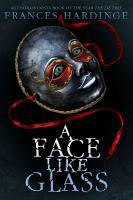
What a wonderfully original and twisty concoction this is.
Consider, for instance, the ruler of the strange, intentionally insular realm in which the story takes place. Kept alive by magic for centuries, his life is fueled by justifiable paranoia about assassination attempts, so much so that he has decided sleep is too great a risk. Instead, he has learned to let the two hemispheres of his brain alternate shifts slumbering, so that only one half of his body is ever active at a time. One eye is coldly rational and verbal; one eye is abstract and intuitive. Remember that if the Grand Steward's right eye is open, he will be cold but fair, but if his left eye is open, that is a time when people fall in or out of favor. If both eyes are open, then you are of special interest to him.
The world the Grand Steward has crafted about himself is a reflection of his paranoia. Subtle machinations have become so ubiquitous that facial expressions have literally ceased to exist. Facesmiths are paid professionals who teach others "faces" they can wear like fashion, all chosen with purpose and none genuine. Citizens jockey for rank, status, prestige, and power, and with extremes of inequality, the lowest social classes only allowed to learn one permanent expression.
That world is a subterranean complex called Caverna. Someone long ago learned there was magic there, and a society was created around the hoarding of that magic. No outsiders may enter; no one may leave. Privileged families learn Crafts where they imbue foods and other mundane items with magical powers to be traded and sold.
Then there are the Cartographers. Caverna's magic can be cautiously tapped by members of the Craft to make True Delicacies, but there is . . . something more to its supernatural power. Attempting to map its properties that defy logic and science seductively warps one's brain into an alien mold. Cartographers speak in such an incoherent torrent of convincing babble that interactions with them are strictly limited to five minute intervals.
"It draws you in. You twist your mind into new shapes. You start to understand Caverna . . . and you fall in love with her. Imagine the most beautiful woman in the world, but with tunnels as her long, tangled, snake-like hair. Her skin is dappled in trap-lantern gold and velvety black, like a tropical frog. Her eyes are cavern lagoons, bottomless and full of hunger. When she smiles, she has diamonds and sapphires for teeth, thousands of them, needle-thin."
"But that sounds like a monster!"
"She is. Caverna is terrifying. This is love, not liking. You fear her, but she is all you can think about."
Into this world tumbles an innocent. An amnesiac girl with no knowledge of that--or any--world. A girl with no guile, whose face betrays her every thought. She is immediately, simultaneously viewed as a horror, a freak, a curiosity, a wonder, and a tool by everyone around her. She is something new dropped into an unchanging environment, and everything instantly swirls around her.
Told from Neverfell's perspective, the story patiently introduces readers to different aspects of Caverna's odd wonders as she encounters them, with very real, very lethal unexpected and surprising dangers around every corner. The plot slips and slithers as much as Caverna's tunnels most delightfully. It's a fascinating, entrancing, sophisticated tale told with vibrant prose.
